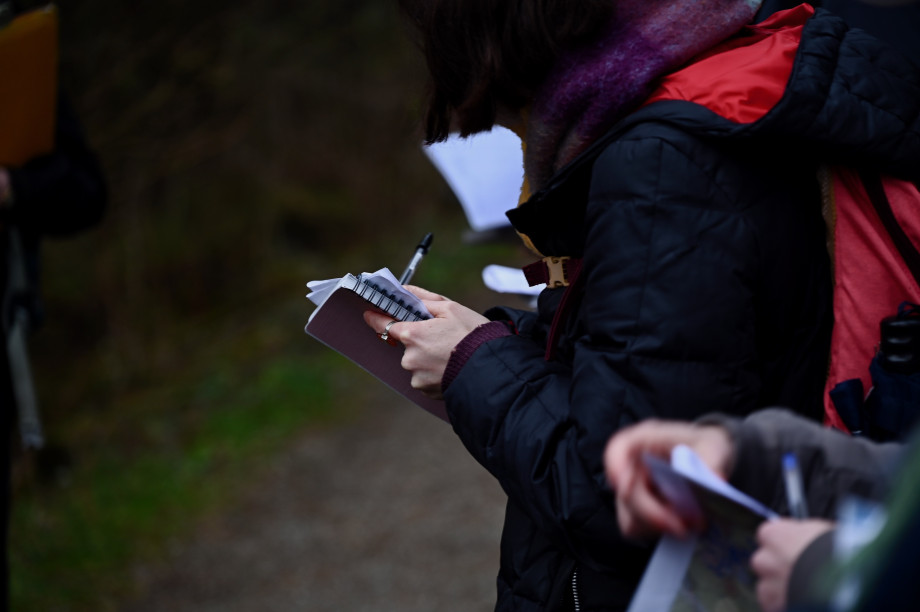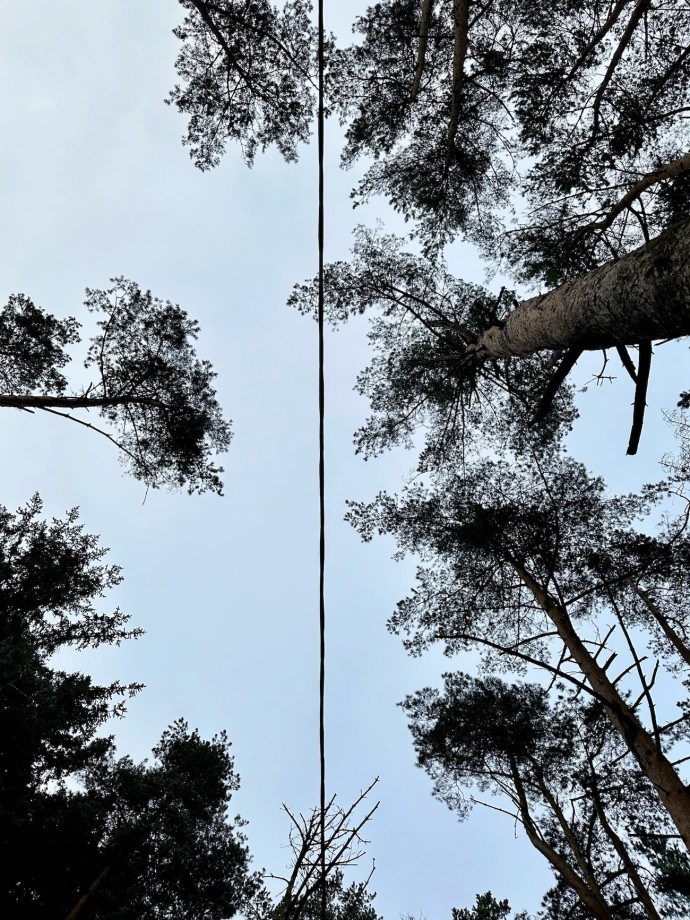This is the second blog post about the Infrastructural Citizen Week 2025, which was organised by the Energy Lives! project in Gothenburg, Stavanger and Aarhus from 24-28 March 2025. In Stavanger, the project team invited to a guided sensory energy walk across university campus and through Sørmarka to explore how energies, technologies, and bodies are connected. Suzanne Ros reflects on her sensory experiences.
Blogginnlegg
Blogginnlegget er skrevet av

As the Wednesday afternoon light softened, we began our energy walk across Stavanger’s university campus, stepping into a world of sound, touch and presence. Our senses became attuned to the environment, shifting between urban landscapes, infrastructural sites and the quieter spaces of nature.
We started in front of the new student building on campus and immediately paused, breathing in with our surroundings. The sound of life was constant – automobiles, the chatter of passing students on e-bikes, the occasional birdsong piercing through the urban white noise. The soft breeze contrasted the heat of the offices inside, a reminder that comfort is subjective. The campus’ energy was restless yet familiar, setting the tone for the journey ahead. Feeling the pulse of our bodies and of the place we were standing in.
As we walked towards the geothermal energy centre, a steady hum filled the air, a collection of industrial tones. Sunlight bounced off the glass of the energy building, momentarily blinding my eyes. This building uses geothermal energy to produce and distribute heating and cooling to the entire campus. Inside, the layered noises depended on my stance – some rooms pulsed with an aggravating intensity, while others hummed in softer, rhythmic waves. As we stepped back outside, the contrast was tangible: the scent of fresh grass, manure and evening air mixed with the remnants of machine-generated noise. These sounds, smells and sightings of big machines of the heating systems informed me to think that energy is tied to movement, convenience and necessity.

Moving our own bodies, we took step after step after step after step in silence. We walked the deep length of the energy wells on campus, one even 650 meters into the bedrock, our steps counted 853 in total until we stepped on a field that was more mud than lawn. Beneath our feet there were forty wells, each stretching 300 meters downward. We maintained the silence. The air sharpened. Children’s voices echoed as they played football in a field nearby, and the occasional stone under my feet reminded me of my body’s presence in this place. My fingers, chilled, regretted the absence of gloves.
As the sun went further west, and we left the campus area, rows of unlit streetlights stood patiently, awaiting their nightly task. Grey tones dominated here – buildings, pavement, sky merging into a monochrome collection. Brown bushes divided parked cars, their branches prickling against my cold fingers. The cars, waiting expectantly for their owners, embodying a different kind of energy – one of waiting, of stillness before movement.

Stepping into the woods, the scent of moss, damp earth, and trees was immediate and calming. A thorned branch caught my coat, holding fast as if questioning my entry into the woods. A large carved rock, seemingly a small bunker of some sort, sat among the trees, coloured by moss. It was, in fact, an old telegraph foundation, once vital infrastructure leading to the sea now surrendered to nature’s slow reclamation. The smell of a decaying tree trunk merged with the anticipation of spring – earth renewing itself and ready to wake up for new beginnings. The telegraph stones told their own story, silent witnesses to changing connections between land, water and history.
Returning to the path I sensed hard asphalt beneath my feet. We re-entered the rhythm of urban life. The bike path reintroduced rush hour’s impatience – cyclists rushing past, hurried steps and frustrated car drivers reminded us of the closing day. A hidden stream murmured beneath the road, a subtle reminder of the land’s waterways and the foreshadowing that we would be going up in the direction that the water came from.
The uphill walk warmed my body, contrasting the cooling evening air. The substation’s humming grew louder, filling the space with its electric presence. My paper notes absorbed the dampness, their texture subtly altered. Beneath the grass, old electrical sheep wire lay buried – again, traces of past infrastructure entwined with the land. Electric echoes interlayered with echoes of the past.

By the walk’s end, my senses were heightened, fully attuned to the layers of the landscape. The elevation had warmed my body, but my nose reddened by the chill, longed for a tissue. My eyes had adjusted to the dimming light, but my ears tired by the spectrum of sounds, craved rest. This walk had been more than a movement through space – it was an experience of energy in all its forms, from industrial hums to the silent stories embedded in stone and soil.
Energy is not just something we consume and use; it is something we feel, something that shapes and is shaped by our presence in the world. Through this walk, I carried and absorbed its rhythms and forms – its histories, its contradictions, its insistence on connection.